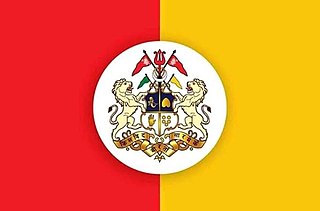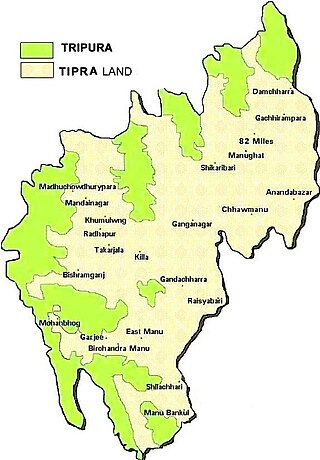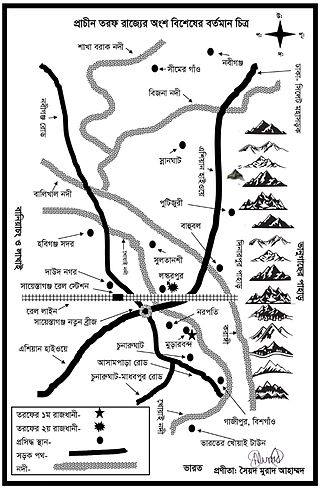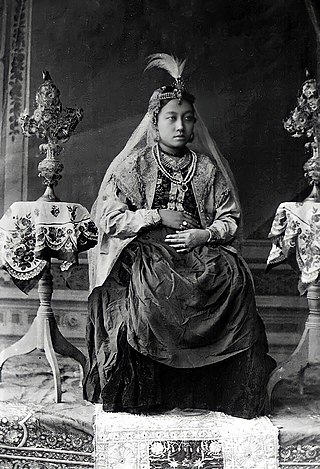This article needs additional citations for verification .(March 2012) |
Rajmala is a chronicle of the Kings of Tripura, written in Bengali verse in the 15th century under Dharma Manikya I. [1]
This article needs additional citations for verification .(March 2012) |
Rajmala is a chronicle of the Kings of Tripura, written in Bengali verse in the 15th century under Dharma Manikya I. [1]
The Rajmala [2] chronicles the history of the Manikya kings of Tripura. While it serves as an invaluable source of information for the region, its historical accuracy in some aspects has been doubted. [3] [4]
The text is split up into six parts, written over the course of several centuries under the patronage of different Tripura monarchs. It was initially commissioned by Dharma Manikya I in 1458, [5] who bestowed the task upon the royal priest Durlabhendra and two Brahman pandits, Sukheshwar and Baneshwar. Their work formed the first part of the text and covered the traditional period of Tripura's history and incorporated various mythological accounts. Subsequent portions were composed during the 16th, 17th, 18th and 19th centuries under Amar Manikya, Govinda Manikya, Krishna Manikya and Kashi Chandra Manikya respectively. The entire revised text was finally compiled by Durgamoni Uzir during the reign of Krishna Kishore Manikya in the mid-19th-century. [6] [7]
The Rajmala presents a list of 149 kings of Twipra as of 1431. The first king of the chronicle is Chandra, the Moon himself; the seventh is Druhyu, one of the sons of Yayati, a Lunar dynasty in mythology. The 46th king is called Tripur (Tripura) as a kind of mythological eponymous ancestor of the Sanskritic name of the kingdom. The list of historical kings begins with the 145th king, Ratna Fa (fl. 1280). He was the first to assume the title Manikya and as such can be considered the founder of the Manikya Dynasty.
| Sl. No. | Name of King | Sl. No. | Name of King |
|---|---|---|---|
| 1. | Chandra | 26. | Basuman |
| 2. | Budh | 27. | Keerti |
| 3. | Pururoba - I | 28. | Kaniyan |
| 4. | Ayu | 29. | Pratishraba |
| 5. | Nahusha | 30. | Pratishtho |
| 6. | Yayati | 31. | Shakrajit (Shatrujit) |
| 7. | Druhyu | 32. | Pratirddan |
| 8. | Babhru | 33. | Pramath |
| 9. | Setu | 34. | Kalinda |
| 10. | Anarta | 35. | Kromo (Krath) |
| 11. | Gandhar | 36. | Mitrari |
| 12. | Dharmma (Gharma) | 37. | Baribarha |
| 13. | Dhrita (Ghrita) | 38. | Karmuk |
| 14. | Durmad | 39. | Kalang (Kalinga) |
| 15. | Pracheta | 40. | Bhishan |
| 16. | Parachi(Shata Dharma) | 41. | Bhanumitra |
| 17. | Parabasu | 42. | Chitrasen (Agha Chitrasen) |
| 18. | Parishad | 43. | Chitrarath |
| 19. | Arijit | 44. | Chitrayudh |
| 20. | Sujit | 45. | Daitya |
| 21. | Pururoba - II | 46. | Tripur Sura |
| 22. | Bibarn | 47. | Subrai (Trilochan) |
| 23. | Puru Sen | 48. | Dakshin |
| 24. | Megh Barna | 49. | Twidakshin |
| 25. | Bikarna | 50. | Sudakshin |
| Sl. No. | Name of King | Sl. No. | Name of King |
|---|---|---|---|
| 51. | Tardakshin | 76. | Muchung Fa (Harihar) |
| 52. | Dharmataru (Dharmatar) | 77. | Maichung Fa (Chandrashekhar) |
| 53. | Dharmapal | 78. | Chandraraj (Tabhuraj or Tarurai) |
| 54. | Sadharma (Sudharma) | 79. | Tarfanai (Tripaly) |
| 55. | Tarbong | 80. | Sumanta |
| 56. | Debang | 81. | Roopabanat (Shretha) |
| 57. | Narangita | 82. | Tarham (Tarhom) |
| 58. | Dharmangad | 83. | Kha Ham (Hariraj) |
| 59. | Rukmangad | 84. | Kotor Fa (Kashiraj) |
| 60. | Somangad | 85. | Kalator Fa (Madhob) |
| 61. | Nojugrai (Nogjog) | 86. | Chandra Fa (Chandraraj) |
| 62. | Torjung | 87. | Gajeshwar |
| 63. | Tor Raj (Rajdharma) | 88. | Beerraj - II |
| 64. | Hamraj | 89. | Nageshwar (Nagpati) |
| 65. | Birraj | 90. | Sikhiraj (Siksharaj) |
| 66. | Shriraj | 91. | Debraj |
| 67. | Shriman (Shrimanta) | 92. | Dhusrang (Durasha or Dhara Ishwar) |
| 68. | Lakshmitaru | 93. | Barkeerti (Birraj or Biraj) |
| 69. | Tarlakshmi (Roopban) | 94. | Sagar Fa |
| 70. | Mailakshmi (Lakshmiban) | 95. | Maloy Chandra |
| 71. | Nageshwar | 96. | Surjyarai (Surjya Narayan) |
| 72. | Jogeshwar | 97. | Achong Fanai (Indra Keerti or Uttang Fani) |
| 73. | Ishwar Fa (Neeldhwaj) | 98. | Beer Singha (Charachar) |
| 74. | Rangkhai (Basuraj) | 99. | Hachung Fa (Achang Fa or Surendra) |
| 75. | Dhanraj Fa | 100. | Bimar |
| Sl. No. | Name of King |
|---|---|
| 101. | Kumar |
| 102. | Sukumar |
| 103. | Twisarao (Beerchandra or Toksarao) |
| 104. | Rajyeshwar (Rajeshwar) |
| 105. | Nageshwar (Misliraj or Krodheshwar) |
| 106. | Twisong Fa (Tejong Fa) |
| 107. | Narendra |
| 108. | Indrakeerti |
| 109. | Biman (Paimaraj) |
| 110. | Yashoraj |
| 111. | Gandhar |
| 112. | Gangaraj (Rajganga) |
| 113. | Sukurai (Chitrasen or Chhakru Rai) |
| 114. | Pratit |
| 115. | Misli (Marichi, Malsi or Marusom) |
| 116. | Gagan (Kathuk) |
| 117. | Keerjit (Noaraj or Nabrai) |
45. Dharma Manikya 146. Dhwaja Manikya 147. Dev Manikya 148. Indra Manikya 149. Vijay Manikya 150. Ananta Manikya 151. Uday Manikya 152. Jay Manikya 153. Amar Manikya 154. Rajdhar Manikya 155. Jasodhar Manikya 156. Kalyan Manikya 157. Govinda Manikya 158. Chatra Manikya 159. Ramdev Manikya 160. Ratna II 161. Narendra Manikya 162. Mahendra Manikya 163. Dharma II 164. Mukunda Manikya 165. Jay Manikya 166. Indra II 167. Vijay II 168. Krishna Manikya 169. Rajdhar Manikya 170. Ramganga Manikya 171. Durga Manikya 172. Kasicandra Manikya 173. Krishnakisor Manikya 174. Isan Manikya 175. Birchandra Manikya 176. Radhakisor Manikya 177. Birendra Kisor Manikya 178. Bir Bikram Kisor Manikya 179. Kirit Bikram Kisor Manik

The State of Tripura, in northeastern India, has a long history. The Twipra Kingdom at its peak included the whole eastern region of Bengal from the Brahmaputra River in the north and west, the Bay of Bengal in the south and Burma to the east during the 14th and 15th centuries AD.

The Tripuri are a Tibeto-Burman-speaking ethnic group of Bangladesh and Northeast Indian state of Tripura. They are the descendants of the inhabitants of the Twipra/Tripura Kingdom in North-East India and Bangladesh. The Tripuri people through the Manikya dynasty ruled the Kingdom of Tripura for over 600 years starting from 1400 A.D. until the kingdom joined the Indian Union on 15 October 1949. The Tipra Dynasty was established in 590 AD.

Debbarma is the main clan of Tripuri community, predominantly in state of Tripura, India and Bangladesh who speak Kokborok, a Tibeto-Burman language.
The Twipra Kingdom was one of the largest historical kingdoms of the Tripuri people in Northeast India.

The Manikya dynasty was the ruling house of the Twipra Kingdom and later the princely Tripura State, what is now the Indian state of Tripura. Ruling since the early 15th century, the dynasty at its height controlled a large swathe of the north-east of the Indian subcontinent. After coming under British influence, in 1809 they transitioned from feudal monarchs into rulers of a princely state, though the Manikyas maintain control of the region until 1949, when it ascended in union with India.
The Tripuri calendar is the traditional solar calendar used by the Tripuri people, especially in the context of Tripuri irredentism. Its era, the "Twipra Era", "Tripura Era" or Tripurabda is set at 15 April AD 590.
Tripuri Kshatriya is a Vaishnav caste group which encompasses almost all the members of the Tripuri, Reang, Jamatia and Noatia ethnic groups, most of whom live in the Indian state of Tripura. The Tripuri Royal Family belonged to the Tripuri ethnic group, from the Debbarma clan. Originally the term "Tripur Kshatriya" was used to denote the Tripuri ethnic group only, but in due time, the Maharajah included the remaining three ethnic groups as well, in an attempt to foster a sense of kinship among his people. With the influx of the Bengali immigrants from neighboring places, the Tripuris lost their majority in their own kingdom and the Maharajah's power was taken away by the Indian government. Formerly, the community was organized under the Tripura Kshatriya Samaj, which was headed by the Maharajah of Tripura himself.

Tipraland is the name of a proposed state in India for the indigenous Tripuri people in the tribal areas of the Tripura state. They demand the Tripura Tribal Areas Autonomous District Council and some surrounding areas to be made into a separate state from Tripura. The proposed state covers 68% of the total geographical area of the Tripura and is home to over one-third of the total population of Tripura.

Tripura State, also known as Hill Tipperah, was a princely state in India during the period of the British Raj and for some two years after the departure of the British. Its rulers belonged to the Manikya dynasty and until August 1947 the state was in a subsidiary alliance, from which it was released by the Indian Independence Act 1947. The state acceded to the newly independent Indian Union on 13 August 1947, and subsequently merged into the Indian Union in October 1949.
Pratap Manikya was a Maharaja of Tripura during the late 15th century.

Ratna Manikya I, also known as Ratna Fa, was the Maharaja of Tripura from 1462 to the late 1480s. Though he had gained the throne by overthrowing his predecessor, Ratna's reign was notable for the peace and prosperity it had entailed in the region. He extensively reformed and modernised the government and closely allied it with neighbouring Bengal, resulting in a lasting cultural influence in Tripura.
Dharma Manikya I, also known as Dangar Fa, was the Maharaja of Tripura from 1431 to 1462. His reign was notable for its territorial expansions as well as for his religious and cultural contributions.
Maha Manikya, also known as Chhengthung Fa, was the Maharaja of Tripura from about 1400 to 1431. Contrary to narratives provided by early histories, evidence indicates that Maha Manikya was the founder of the kingdom, having established dominance over neighbouring tribes in the early 15th century. He is further thought to be the first holder of the title "Manikya", taken in recognition of a historic victory over the neighbouring Bengal Sultanate. The dynasty which he founded continued using the title until Tripura's merger with India in 1949.

Vijaya Manikya II, also spelt Vijay or Bijoy, was the Maharaja of Tripura from 1532 to 1563. Succeeding to the throne at a young age, Vijaya proved himself to be a formidable military leader, initiating a series of conquests into several surrounding kingdoms, including the powerful Bengal Sultanate. During Vijaya's reign, the might and influence of Tripura reached its zenith, leading to him being viewed as one of its greatest monarchs.
Narendra Manikya was the Maharaja of Tripura from 1693 to 1695.

Taraf, previously known as Tungachal, was a feudal territory of the Sylhet region in Bengal and was under many petty kingdoms in different periods of time. It was part of what is present-day Habiganj District in Bangladesh.
Joy Manikya II was the Maharaja of Tripura during the mid-18th-century. He originally gained the throne through popular approval for his military hostility to the Mughal Empire. However, Joy spent much of his reign warring against various relations to maintain his grip on it, in particular with his cousin Indra Manikya II.
Udai Manikya II was the Maharaja of Tripura briefly during the mid-18th-century, having laid claim to the throne during a power struggle between his relatives Joy Manikya II and Indra Manikya II.

The royal marriage alliances between the Meitei royal family, Ningthouja dynasty of Manipur kingdom and the Manikya dynasty of Tripura kingdom brought good relationship between the two states as well as assimilation of the two cultures. The Tripuri kings married not only the Meitei princesses but also many other ladies of commoners' families of Meitei community. Meitei queens were remembered for their contributions to the development of the Tripuri society. So, they were given high status in the royal house of Tripura.